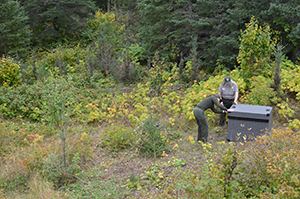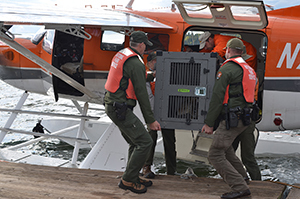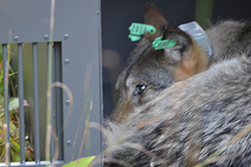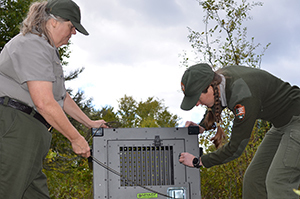 The Isle Royale experience: wolf translocation
By JOHN PEPIN
Deputy public information officer
Michigan Department of Natural Resources
 Though this
was indeed the place, it didn’t look now like anywhere that would gather the
attention of so many eyes and ears, hearts and minds.
The
afternoon was gray, with silvery clouds passing over the face of the sun,
blocking her warming brilliance. Sharp winds off the bay at Lake Superior
hinted a snowfall could be around the bend just anytime now.
This was
the top of a gradual slope where a trail ran down through the low brush – with
wild yellow daisies, purple clover-like flowers, young oaks, maples and scrub
brush that looked like thorn apple, but wasn’t.
There was
plenty of balsam fir here too, or what was left of it. There are hundreds of
moose on this majestic archipelago. The firs, whose needles and sap hold the
crisp aromatic smell of Christmastime trees, are a favored food.
|
It was
these moose that were indirectly drawing all the attention to this relatively
indistinct place in the forest. Their increase in numbers coinciding with a
decline to just two animals in Isle Royale’s long-studied wolf population has
left the moose without a significant predator presence. Without predation, the
negative impact to the island ecosystem from the proliferation of moose is
enhanced, posing concerns of significant long-term damage.
So, on
this day, team members of many stripes were working together to release two
wolves on the island. The wolves had been trapped in Minnesota and were flown
to this grand island in a fiery orange float plane, which I heard well before I
saw it banking in the blue skies over the treetops.
On this
slope, which sat above a swampy area populated with thick green cedars, the
first wolf – a 4-year-old female – would be set loose. The release would mark
the beginning of an effort to move 20-30 wolves to the island over the next
three to five years, including some wolves from Michigan.
 There
were playful red foxes on the island – no bears and no deer – numerous eagles,
a chattier form of island squirrel, several colorful types of garter snakes
and, on this particular day, dozens of yellow-rumped warblers – one of the
first warblers to arrive in spring and among the last to leave in fall.
They
seemed to be everywhere I went. I could hear their simple, but distinctive,
“chip” notes from the bushes and trees. They would fly past me at a very short
distance. One bird allowed itself to be held in the hand of a red-bearded
colleague after it was discovered flapping around inside the hull of a boat.
As I sat waiting,
I noticed one of these small birds that didn’t appear to have any fear of the
animal inside the carrier.
The door
had been opened and the wolf inside lay curled, with her head up, watching and
waiting. At any moment she chose, she could run from the crate and be free to
roam the island’s 132,000 acres.
|
From
where I sat, which was several feet above the scene, I quietly watched this
warbler land on the top of the crate that contained the wolf. The bird
fluttered several times along the sides of the box.
Then it
landed in front of the open door. It hopped
around in the grass, undoubtedly in view of the watching wolf. Within a
moment or two, it fluttered back up to the top of the box.
“Chip,
chip,” the bird announced.
Then,
back onto the ground, it was back outside the open door.
I thought
certainly this time, the bird would be snatched up by the wolf and promptly
eaten. But the wolf – colored tan, gray, white and black – stayed inside the
now relatively familiar confines of the box, even though the door was open.
 There
were others here with me that day, watching and waiting for the
wolf to make its dash. Among them, a storied ecologist and his wife who have
known the wolves and moose of this island for decades on end.
There
were also National Park Service folks who had a great deal invested too – gracious and
kind island dwellers – hoping to restore an essential dynamic to the island’s
ecosystem.
The
shutters, lenses and clicking of cameras were hidden among the short brush and in the trees down the path.
I could
see the scene particularly well. In an old scraggly tree not far from me the
warbler from the box landed several times, continuing to make its “chipping”
sounds.
While the
watch continued, the second wolf was being moved into position along another
trail. In this place, the autumn had touched the trees with the birch leaves
yellow and fluttering among more spruces and firs.
The door
to this second wolf’s box would soon be opened too.
|
Like the
female wolf, this 5-year-old male, similarly colored, would remain in its crate
though the door was held wide open. Ravens flew overhead through the trees,
squawking loudly.
The male
wolf didn’t leave until the shadows of night had fallen and the sounds of
grunting moose were heard from the woods.
In the
days ahead, this wolf’s face – and
that of the female wolf – would appear on images collected from a
trail camera, positioned where parts of moose had been provided for the wolves
by the translocation team.
 On those
trail camera stills, the wolf appeared in the frame warily, long enough to grab
and drag away something to eat. Ravens and bald eagles were in the camera shots
too, along with two red foxes.
Back on
the slope, the female wolf remained in the crate.
As I continued
waiting and watching, I thought about those who have come to hate wolves and
those who love them, as though they were their own pets – opposite ends of a
wide human spectrum.
For me, I
have always seen wolves as integral parts of nature’s living world – wild
animals, revered by American Indians and many more.
When I
was a kid, I never had the opportunity to ever see a wolf. I had heard about a
small handful brought to our little corner of the world in Michigan’s Upper Peninsula,
which all soon died, one way or another, at the hands of humans.
I
remember being saddened by that.
|
Like the
bald eagles and peregrine falcons, which I also never saw as a kid, wolves have
been returned to us. To me, this is a wrong being righted, putting nature back
in place.
When I
finally did see a wolf in the wild, it wasn’t until my own kids were almost
grown up. I was traveling fast along a highway. A black wolf and a gray wolf
stood at the side of the road, waiting to cross.
 Everything
slowed down – like slow motion, as I passed – looking. The wolves embodied wild
nature, beautiful and raw. I am hopeful my grown sons will see wolves one day
and my young granddaughter will have wolves among her experiences too.
The
little warbler never left while the first wolf remained in the crate. It continued to hop around on the ground, on top and alongside
the box.
With the
sound of the float plane cranking its engine, the wolf popped her head up. She looked
around and peeked to each side outside the door of the crate.
Her feet
made a scuffing sound as they scraped along the bottom of the box. The
wolf shot out of the box. As the cameras clicked, she ran a few
steps down the trail before turning to run through the low shrubs.
She then
cut toward the base of some spruce trees and thick undergrowth. Just before she
ducked underneath and disappeared, she turned her head and looked straight up,
right at me.
Later, as
I walked along the cold lakeshore, a merlin dipped after some warblers hopping
carelessly in the open along the planks of an old dock. I wondered if the bird
I’d seen back at the wolf crate was among them.
With
nighttime falling, I turned up the trail and headed toward the top of the
ridge, already certain I would never forget this day.
Learn more about the National Park Service’s Isle Royale Wolf Translocation
Project.
Check out
previous Showcasing the DNR stories in our archive at mi.gov/dnrstories. To
subscribe to upcoming Showcasing articles, sign-up for free email delivery at mi.gov/dnr.
|
/Note to editors: Media contact: John Pepin, 906-226-1352. Accompanying photos and a text-only version of this story are available below for download. Caption information follows. Credit Michigan Department of Natural Resources, unless otherwise noted.
Text-only version of story.
Carrier: Wolf translocation team members bring the
first wolf ashore Wednesday, Sept. 26, 2018 at Isle Royale National Park.
Door: Isle Royale National Park Superintendent
Phyllis Green and ecologist Lynette Potvin open the door to release the first wolf at the island Wednesday,
Sept. 26, 2018.
Glimpse: The last glimpse of the first wolf
translocated to Isle Royale National Park Wednesday, Sept. 26, 2018 as she
slips into the forests on the island.
Interview: National Park Service videographer
Jacob Frank interviews Isle Royale National Park Superintendent Phyllis Green,
after the first wolf translocated to the island was released, Wednesday, Sept.
26, 2018.
Male: The
second gray wolf brought to Isle Royale National Park Wednesday, Sept. 26, 2018
rests in his carrier Wednesday, Sept. 26, 2018 late in the day.
Move: Wolf translocation team members move a
carrier holding the first wolf moved to Isle Royale National Park, Wednesday,
Sept. 26, 2018.
Open: Isle Royale National Park Superintendent
Phyllis Green, left, and ecologist Lynette Potvin open latches on a carrier
holding the first wolf moved to the park, Wednesday, Sept. 26, 2018.
Plane: A
plane carrying the first two wolves to be translocated to Isle Royale National
Park arrives Wednesday, Sept. 26, 2018.
Run: An artistic photo shows the first gray wolf
translocated to Isle Royale National Park on the move away from her carrier,
Wednesday, Sept. 26, 2018.
Warbler: A yellow-rumped warbler along a wooden dock at
Isle Royale National Park./
|